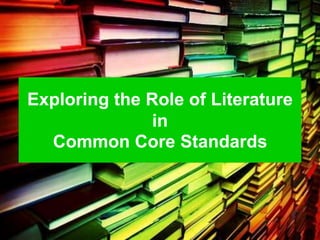Exploring the role of literature in common core
- 1. Exploring the Role of Literature in Common Core Standards
- 3. Why Are We Worried About Fiction? 70% 50% 55% Nonfiction 50% 45% 30% Fiction 4th Grade 8th Grade 12th Grade Fiction to Nonfiction Shift
- 4. What About Independent Reading? ItŌĆÖs in there ŌĆō but buried! Appendix A ŌĆō page 8 ŌĆ£Students need opportunities to stretch their reading abilities but also to experience the satisfaction and pleasure of easy, fluent reading within them, both of which the Standards allow for. As noted above, such factors as studentsŌĆÖ motivation, knowledge, and experiences must also come into play in text selection.ŌĆØ
- 5. Selecting Literature for the Common Core Classroom Source: Common Core State Standards for English Language Arts & Literacy in History/Social Studies, Science, and Technical Subjects, Appendix A
- 6. Evaluate Classroom Novels Lexile 570 Lexile 700 Lexile 830 Lexile 870 Lexile 810 Lexile 700 Lexile 970 Lexile 760 Lexile 750
- 8. How do you keep up with the latest trends in books?
- 9. Why is Nonfiction emphasized? 70% 50% 55% Nonfiction 50% 45% 30% Fiction 4th Grade 8th Grade 12th Grade Fiction to Nonfiction Shift
- 10. Informational Text Ideas for the Classroom
- 12. Nonfiction Blogs, Lists and Webinars NCSS Outstanding Social NSTA Outstanding Studies Trade Books Science Trade Books Others American Book Awards Audie Awards Black Caucus of the ALA Literary Awards Boston Book Review Literary Award Bread Loaf Bakeless Prize Costa Book Awards Governor General's Literary Awards Kiriyama Pacific Rim Book Prize Lannan Literary Awards Minnesota Book Awards National Book Award National Book Critics Circle Award Pulitzer Prize Reference and User Services Association Awards Robert F. Kennedy Book Award
- 13. Librarian at Palmetto Middle School Tamara coxt@anderson1.k12.sc.us @coxtl on Twitter Cox Blog: www.e-literatelibrarian.blogspot.com Kristen Hearne Librarian at Wren Middle hearnek@anderson1.k12.sc.us @KHearne on Twitter Blog: http://thelibrarianinthemiddle.blogspot.com/ Monique German Librarian at Powdersville Middle germanm@anderson1.k12.sc.us @bibliogerman on Twitter http://thisshelfreserved.blogspot.com/
Editor's Notes
- #4: Common Core Standards define a shift in the amount of fiction to nonfiction that transitions from 50/50 in fourth grade to 70% nonfiction by the end of high school.
- #5: Although the goal is to increase studentsŌĆÖ ability to read increasingly complex text, the CCSS recognize that pleasure reading should be included. We need to remind teachers that the percentages are school wide not just in English Language Arts
- #10: Nonfiction reading skills are necessary for college and career readiness, reading nonfiction is a skill that has to be taught, students need to know nonfiction text features and how to read charts and diagrams, how to read to solve a problem or argue a point using a text
- #11: Textbook WalkNonfiction Text Features PosterHighlighting StrategiesInfographic Activity
- #12: Book passesBulletin BoardsSpeed TablesDisplaysQR CodesFiction/Nonfiction Pairs












